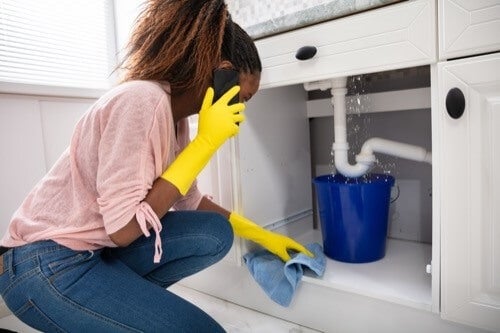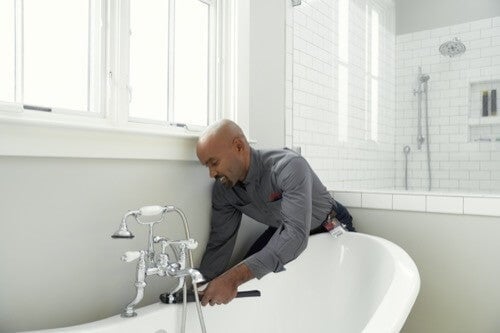Silent But Costly: How to Find a Bathroom Leak

Many plumbing issues are hard to detect, but prolonged leaks can become expensive to repair. AHS has the tips and tricks you need to detect a hidden bathroom leak.


Many plumbing issues are hard to detect, but prolonged leaks can become expensive to repair. AHS has the tips and tricks you need to detect a hidden bathroom leak.
We’ve all been there, listening to the persistent drip ... drip... drip of a pesky, leaky bathroom faucet. However, not all bathroom leaks are so obvious. There may be unseen and undetected leaks in your bathroom, and they can cause serious plumbing issues if not repaired. These leaks can generate a host of other problems, too – expensive water damage to walls and floors, mold, and mildew. They can even be the cause of a high water bill.
Hidden bathroom leaks can do extensive damage to a home, much more than the plumbing itself. Repairs can quickly add up and become very expensive. For costly repairs like this, you may want to consider a home warranty to help keep you financially covered.
There is good news. These leaks can be found and fixed before they have a chance to do their damage. So, before you get to the point of shelling out big money for repairs, it’s worth your time and effort to make sure your home doesn’t have hidden bathroom leaks.
Signs of a hidden leak
First things first, how can you identify them? Luckily, if you know what to look for, hidden leaks in the bathroom have some telltale signs.
Musty odor
Do you notice an earthy, musty smell in your bathroom? Does spraying air fresheners do nothing to help? This is a dead giveaway. Don’t ignore it. Find the leaking pipe, and you will find the source of the odor. Look closely behind your faucets, cabinets, around your toilet – basically, anywherethere are pipes and a water source.
Ceiling stains
There can be many causes for ceiling stains. One of the most common is a hidden water leak. Any brownish or dark stain on the ceiling can be an indicator. If you’re lucky and the stain is located directly under your upstairs bathroom, a leak is most likely the culprit. Water, however, can move a long way under your upstairs flooring and appear on the ceiling many feet away from the leak. Also, a sagging ceiling under the bathroom should be a flashing red alert — because the entire ceiling could come crashing down!
Damaged walls and floors
Water stains, blistering paint, or discolored buckling floorboards may also help point the way to the problem. Even worse, if you notice soft spongy floors, you have a leak. One important note: People often think that steam from showers may cause many of these issues. In most cases, it does not.
Mildew or mold
Mold loves darkness and moisture—like behind walls and under floorboards. That also happens to be the places many pipes are located. Although it’s very normal for mold to form where water naturally accumulates, like in shower corners, if you see mold or mildew in places away from the shower, it could be an indication of a leak. Mold can cause health problems, so it’s very important to find the source and get rid of it.
Wetness in cabinets

Cabinets and vanities are prime spots when checking for leaks. The pipes underneath the sink bowl are one of the most common causes of hidden leaks. Look for areas of wetness. It may be an easy fix, like tightening a nut, but it could also be a pipe or valve that needs to be replaced.
Wobbly toilet
If you have a toilet that feels more like a rocking chair, the wax ring that connects the base of the toilet and provides a water-tight seal to the pipe on the floor may be worn. If you don’t already see water on the floor, it’s probably just a matter of time.
Even with a good wax seal, your toilet can still be leaking inside. How do you find these hard-to-detect toilet leaks? If you notice that the toilet’s regulator randomly turns on, you should check the tank’s water level. First, turn off the shut-off valve, then mark the water line on the inside surface of the tank with a pencil. Come back later and check to see if the level has dropped.
Loose faucet knobs
If the knobs on your faucets seem loose, they could be leaking without you noticing. Water can seep into the gaps, follow the pipes, and drop off in hidden places. If a faucet is loose in your hand, tighten it or replace it. If it isn’t leaking now, it will.
Cracked seals in showers and bathtubs
It’s important that you look for gaps between the seals in and around your shower, bathtub, and walls. Any cracks or gaps could be a problem, and while you’re doing that, be sure to look for peeling or bubbling paint on the walls.
Thinking about coverage?
Security for your home. Protection for your budget.
What to do about it
So, you found the source of the leak. Congratulations! Now what? It’s time to take the next step and get the leak fixed. Some repairs are easy to do yourself, such as tightening connections and nuts. Others, like replacing drains or fixtures, may require a higher level of plumbing skills.
It’s often better to call a professional plumber. Aside from repairing the issue and assuring the job gets done right, they can help you diagnose other problems and suggest a fix to ensure no additional damage happens to your home.

Fix the leak in your wallet
The costs of bathroom leaks can add up. Aside from the initial expense of plumbing repairs, leaks can wreak havoc on flooring, walls, and sometimes the very structure of the house. The total bill could be thousands of dollars. While you can save some money on simple DIY fixes, it’s important to protect yourself against the costs of plumbing repairs.
American Home Shield® offers home warranty protection for things like leaks and breaks in water, gas, and drain lines. Hardware such as faucets, shower heads, whirlpool bathtub motors and pumps, as well as other home systems and appliances you rely on. Protect yourself against unnecessary plumbing costs and find an American Home Shield® home warranty plan that’s right for you. We make it easy to get started and shop for plans.
See how a plumbing protection plan can help with covered repairs.

AHS assumes no responsibility, and specifically disclaims all liability, for your use of any and all information contained herein.
Have a plan for your home when things don't go according to plan
Shop Home WarrantiesDevelopment